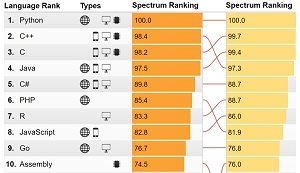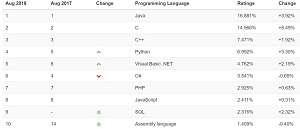News
Python, Java Top New Programming Language Popularity Rankings
- By David Ramel
- August 3, 2018
New programming language popularity reports are out, showing perennial leaders Python and Java holding on to the No. 1 spots in two indices.
IEEE Spectrum published its fifth annual interactive ranking of the top programming languages, which sees 2017 champ Python again in first place. Meanwhile, the TIOBE Index for August 2018 has Java at No. 1, just like last year.
While both indices basically feature the same cast of familiar characters in their top echelons, there were some changes of note.
For example, in the IEEE Spectrum rating, C++ vaulted into the No. 2 slot, while it was No. 4 last year. Another big mover in the top 10 was Assembly, which went from No. 13 to No. 10. PHP went from No. 8 to No. 6. Falling one position each were C, Java, R and JavaScript.
"Python has tightened its grip on the No. 1 spot," IEEE Spectrum said in a post. "Last year it came out on top by just barely beating out C, with Python's score of 100 to C's 99.7. But this year, there's a wider gap between first and second place, with C++ coming in at 98.4 for the No. 2 slot (last year, Java had come third with a score of 99.4, while this year its fallen to 4th place with a score of 97.5). C has fallen to third place, with a score of 98.2."
IEEE Spectrum -- a magazine associated with the organization that used to be generally called the Institute of Electrical and Electronics Engineers -- publishes an interactive app that includes sectors such as Web, Embedded, Mobile and Enterprise, along with user-selected weights for criteria such as Trending, Jobs, Open and Custom, to compile its rankings. The data presented here reflects the default settings that are meant to target the typical IEEE member and Spectrum reader.
 [Click on image for larger view.]
IEEE Spectrum 2018 Rankings, Compared with 2017 (source: IEEE Spectrum)
[Click on image for larger view.]
IEEE Spectrum 2018 Rankings, Compared with 2017 (source: IEEE Spectrum)
IEEE Spectrum offered two reasons to explain why Python continues to gain programmer mindshare. One is that it's now listed as an embedded language, taking advantage of higher-power modern hardware that lets microcontrollers more easily host a Python interpreter, whereas embedded programming used to favor compiled languages. The second reason is the decline of stats/Big Data specialist R, which fell from No. 5 in 2016 to No. 6 in 2017 to No. 7 in 2018.
The August 2018 TIOBE Index, meanwhile, shows Python approaching the top 3 for the first time.
"Programming language Python is getting very close to the top 3 of the TIOBE index," the new report said. "If Python surpasses C++ and becomes number 3, this will be an all-time high for the scripting language of Guido van Rossum. In 2005 there was a study what programming language was taught most at US universities and Java appeared to be a clear number one with 60 percent of all introductory programming courses. Similar research was conducted almost 10 years later in 2014 and the outcome was different.
 [Click on image for larger view.]
TIOBE August 2018 Rankings, Compared with 2017 (source: TIOBE Index)
[Click on image for larger view.]
TIOBE August 2018 Rankings, Compared with 2017 (source: TIOBE Index)
"This time Python was a clear winner with more than 70 percent 'market share.' This Python boost is also visible in the TIOBE index. But industry is adopting Python as well. The Python programming language started as a successor of Perl to write build scripts and all kind of glue software. But gradually it entered also other domains. Nowadays it is quite common to have Python running in large embedded systems. So it is very likely that Python will enter the top 3 and even might become the new number 1 in the long run. Other interesting news is that Hack, Groovy and Julia re-entered the top 50, whereas TypeScript lost a few places and is now at position 62."
Overall, there was little movement in the TIOBE top 10, though Assembly for the first time cracked the top 10, ranking at No. 10, the same position it holds in the new IEEE Spectrum ranking.
The definition of the TIOBE Index can be found here, while a detailed description of IEEE Spectrum methods and sources can be found here.
About the Author
David Ramel is an editor and writer at Converge 360.